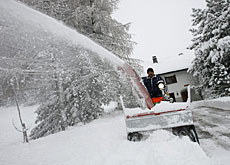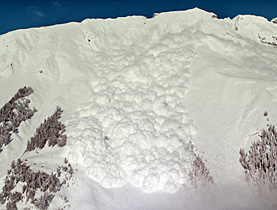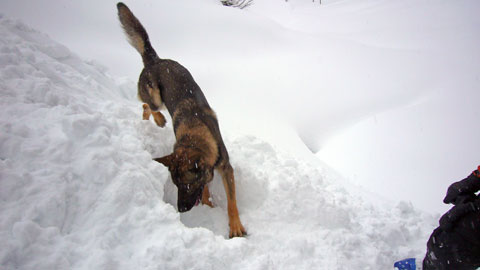High-tech radar sounds out snowfall

Perched on a mountain top in the resort of Davos is a state-of-the-art radar which, as winter sets in, should help gauge exactly how much snow is falling in the area.
Combined with knowledge gained from weather sensors across the valley, the results could help scientists improve avalanche prediction in a tough mountain environment.
It is a crisp day in Davos – known to many as the home of the World Economic Forum – and at an altitude of 1,500 metres, the highest town in Europe.
Through its Federal Institute for Forest, Snow and Landscape Research (SLF), it also has one of the world’s leaders in snow and avalanche research. It is also the body that prepares the nation’s avalanche warning bulletins.
Although only October, snow has already fallen. We take the cable car and by the time we have climbed on foot for half an hour to reach the top of the 2,150-metre Jakobshorn mountain, it stands 30 centimetres deep.
A group of journalists and scientists are here to look at the SFr 500,000 ($491,000) X-Band precipitation radar, an almost one-ton device which was winched onto the mountainside by helicopter in September and will be in operation until spring.
Water towers
“Mountains are the water towers of the world and in the Alps they provide water to almost all Europe. The main water input comes from precipitation,” explained Alexis Berne, an assistant professor at the Federal Institute of Technology Lausanne (EPFL), which installed the radar.
It is difficult to measure precipitation in the Alps as rain and snowfall are very variable in time, space and scale, especially on unpredictable mountainsides.
But this radar, which uses three-centimetre pulses to interact with falling rain and snow, will be able to overcome some of these challenges.
“The high-resolution radar data will contribute to better understanding the small-scale features and dynamics of precipitation in the Alps, and the radar will provide information on the type of precipitation and eventually on the types of snow,” Berne said of the high-tech device, of which there are fewer than ten used for research in Europe.
Snow sensors
“Our goal is to better quantify how much of what is falling where. Such information will be useful to the SLF researchers working on natural hazards and avalanches in particular.”
The radar information is sent back via an internet connection to Lausanne, where it is analysed and algorithms developed to obtain reliable precipitation estimates. Meanwhile, the SLF has been setting up extra weather sensors across the valley in their field-testing area around the Wannengrat and Latschuel mountains, which is exactly in the radar’s zone.
Laser scanning is being used to show where the snow is falling and how it is transported, for example by wind. Disdrometers measure the shape and speed of falling raindrops and snowflakes.
The idea is to relate what is seen by the radar in terms of precipitation to what is actually occurring on the ground, said Michael Lehning, head of SLF’s snow and permafrost research.
Crucial data
Snow distribution patterns in particular are crucial in avalanche predication, he said.
“Last winter during our fieldwork a huge avalanche was released on the Latschuel mountain which carried one of our collaborators a few hundred metres,” he told swissinfo.ch.
“The reason was the even snow distribution on that mountain, while the much steeper mountain on the left, the Wannengrat, didn’t produce any avalanches because it had a very heterogeneous snow deposition – some places with no snow and others with all the snow.”
Seeing how much snow has fallen could also be useful for gauging how much meltwater will come, especially in light of the expected future water shortages, he added.
“This collaboration between the EPFL and the SLF will produce a lot of synergetic benefits. It’s something that is not done elsewhere in the world in this combination.”
World-leading
The radar and sensors are part of the Swiss Experiment, a wider project which aims to use high tech to pool environmental research data from Switzerland.
Swiss Experiment project manager Nicholas Dawes has been helping to set up the sensors.
“There are 28 meteostations now around Davos measuring at a fine density both in temporal and spatial coverage,” Dawes told swissinfo.ch as he pointed out the stations through a telescope.
The sensors even organise between themselves which station will send back the data.
“The idea is to get the best results from whatever new technology is available and hopefully this should give us some world-leading results,” Dawes said.
Isobel Leybold-Johnson in Davos, swissinfo.ch
The SLF has contributed to avalanche prediction for more than 60 years, publishing snow and avalanche warnings via radio, television, the internet, fax and telephone and the press.
Information is gathered from manned weather stations, observers, weather forecasts and from SLF’s own data.
Two daily assessments are made of the current avalanche situation, one at 5pm and one at 8am.

In compliance with the JTI standards
More: SWI swissinfo.ch certified by the Journalism Trust Initiative




You can find an overview of ongoing debates with our journalists here . Please join us!
If you want to start a conversation about a topic raised in this article or want to report factual errors, email us at english@swissinfo.ch.